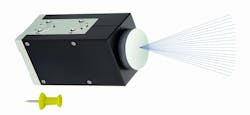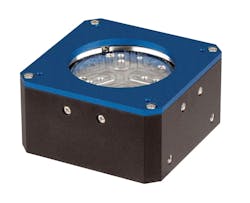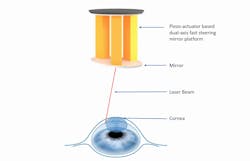Fast steering mirrors manipulate light for free-space optical communications and beyond
Fast steering mirrors (FSMs) are precision devices used to accurately and rapidly control the direction of optical energy or information. These devices are widely used to improve image resolution for astronomical telescopes by correcting errors in a wavefront before it reaches an imaging sensor, effectively “un-twinkling” stars. Image sensor resolution can also be enhanced when an FSM is operated in pixel sub-stepping mode, which moves the sensor or the light reaching the sensor by fractions of an individual pixel.
Optical communications became a new application field for FSMs fairly recently. Within this context, laser light is modulated to carry information without the use of optical fibers. It merely requires a clear line of sight between transmitting and receiving stations.
The primary advantage of this technique, called free-space optical communication (FSO), is cost reduction because it eliminates the need for fiber in the ground. But one downside of terrestrial FSO is its relatively short range, because environmental factors such as rain and fog can reduce performance and reliability as distances increase.
Space-based internet
Fast steering mirrors gained media attention recently for a new type of FSO: a space-based internet. As the number of active satellites continues to expand, astronomer Jonathan McDowell from the Harvard-Smithsonian Center for Astrophysics estimates more than 10,000 active satellites are already orbiting Earth. Other forecasts predict this number will rise to several tens of thousands—possibly reaching as many as 100,000 by the end of the decade (see Fig. 1).
To provide global coverage, low Earth orbit (LEO) satellite networks with thousands of nodes around our planet are necessary. This creates demand for highly precise, space-qualified FSMs, which are essential for keeping the optical signal between transmitters and receivers aligned—and ensuring stable and efficient communication links as a myriad of satellites orbit the Earth at speeds of around 17,000 miles per hour.
FSMs come in single- and multi-axis designs, but dual-axis FSMs are the most common (see Fig. 2). A typical dual-axis FSM consists of a reflective mirror, a pair of actuators, a guiding system, motion-tracking sensors for each axis, and a closed-loop motion controller.
How do they work? The controller reads position sensor feedback and adjusts the actuators' voltage to achieve the desired tip/tilt angle. The motion controller itself receives input from a processing unit, which is fed by optical sensors and the satellite's attitude control system to precisely align the optical transceiver.
Alignment and tracking algorithms
Whenever an optical signal beam must be aligned with a target, efficient algorithms are required to first locate the signal and then optimize it for maximum strength to complement a fast mechanical system. This applies to both microscale and macroscale scenarios—whether aligning an optical fiber to a chip just a few microns away or aligning a laser beam to a small receiver on satellites hundreds of kilometers apart.
The latest breakthroughs in high-speed alignment and tracking algorithms for fiber-optics test and assembly automation can also improve FSO.
Types of FSM drives
For FSMs to be viable for space applications, they must meet SWaP-C2 criteria by optimizing size, weight, power, cost, and cooling of a device or system. Most compact FSMs are driven by either piezoelectric or voice coil actuators. Piezoelectric FSMs typically offer higher resolution, while voice coil steering mirrors (see Fig. 3) allow for larger displacements and greater angles.
Piezo actuators are inherently stiff and do not require power to hold a position, whereas voice coil actuators are inherently soft and provide no holding force when powered off. Depending on the application requirements, either system may be the preferred choice.
Recent breakthroughs in voice coil FSM design include a closed-loop bandwidth of 750 Hz and angular resolution better than 0.1 μrad. For cost-efficient operation, microcontrollers can be implemented at the chip or board level.
Friction-free, maintenance-free designs are essential
For high-frequency applications with a large number of cycles, wear-free and maintenance-free FSM designs are desirable. Frictionless flexure guiding systems and friction-free actuators are considered state of the art.
Flexures do not require lubrication, which is a significant advantage for vacuum and space applications.
Parallel kinematics and differential drives
A standout feature of an advanced dual-axis system is its parallel-kinematics design, which uses coplanar rotational axes and a single moving platform driven by differential actuators. This design preserves polarization rotation and is much more compact than using two single-axis mirrors in series.
For maximum angular stability independent of operating temperature, a differential actuator/sensor setup (push-pull) is recommended. For this setup, any positive or negative extension of the actuators, due to temperature changes, will result only in piston motion (phase shift)—without affecting the angular position of the mirror. This is especially critical for space applications where large temperature swings can occur.
Piezo precision and speed
Piezo steering mirrors offer resolution down to the nanoradian range, along with high dynamics and responsiveness within the millisecond to microsecond range. They are also lightweight, compact, robust, and maintenance-free.
"Piezo" is derived from the Greek word for pressure. The direct piezoelectric effect refers to the generation of electrical charges in a material, commonly used for pressure sensors, microphones, and gas lighters.
The inverse piezoelectric effect describes the phenomenon in which an electric field applied to certain materials causes a dimensional change. This solid-state effect is widely used for precision motion control applications, because the dimensional resolution is virtually unlimited and the mechanical response to an electrical control signal is as fast as the speed of sound in the piezo material. And the exerted forces are significant.
Since the discovery of the effect for natural materials like quartz in the 1880s, the performance of piezo materials has advanced dramatically. Modern piezo actuators are manufactured using multilayer technology similar to ceramic capacitors to reduce operating voltages (from 1,000 V in the past, to 100 V or less today).
PI’s multilayer piezo actuators, which are ceramic-encapsulated, have demonstrated durability—withstanding 100 billion cycles of life testing for the Mars rover space mission.
Fast steering mirror applications beyond FSO
Laser processing is a prominent application that requires precise beam control, which can be managed by FSMs or galvo scanners. A key advantage of the parallel-kinematic FSM design of a single mirror for both axes over traditional two-mirror galvo scanners is a more compact design that prevents polarization rotation.
Within the medical field, ophthalmology is a growing market where FSMs precisely direct laser beams to reshape the cornea (see Fig. 4) to potentially eliminate the need for contact lenses or glasses.
Microscopy is another field where FSMs are used for optical trapping. This technique uses highly focused laser beams to manipulate microscopic particles, such as molecules, without physical contact. The laser generates a force that holds and moves the particles to enable precise control for biological or material science experiments. Microscopy also benefits from image resolution improvements through adaptive optics, a technique where multiple piezo actuators deform the surface of a mirror to correct for aberrations introduced by the refractive index structure of specimens. This technology, also used in astronomy, can improve resolution by an order of magnitude or more.
In defense systems, directed laser energy is an effective method for addressing threats that cannot be mitigated via conventional solutions. Speed and precision are critical for the selected FSM solution, much like other scientific active and adaptive optics applications.
Other applications for FSMs include LiDAR, which is currently being explored by the autonomous vehicle industry.
About the Author
Stefan Vorndran
Stefan Vorndran is VP of marketing at PI (Physik Instrumente; Auburn, MA).



